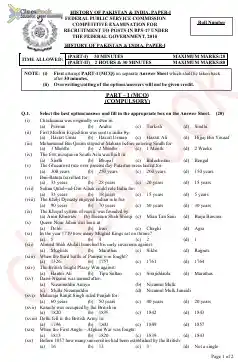Download the CSS Past Papers of History of Pakistan and India 2010 PDF. Review key areas, exam orientation, two strategy tables, and helpful resources for CSS preparation.

The History of Pakistan and India optional subject is a strong scoring choice for CSS aspirants who develop analytical and narrative skills. The 2010 past paper highlighted questions on political decline, colonial policies, reformist leaders, and the challenges of early Pakistan. For students preparing for CSS, this paper remains a guide to examiner priorities.
About the CSS
The CSS (Central Superior Services) Competitive Examination is a rigorous federal-level test administered by the Federal Public Service Commission (FPSC) to select candidates for prestigious civil service roles across Pakistan. The exam’s rules and regulations, covering age limits, eligibility, subjects, and quotas, are detailed in the official CSS Rules section on the FPSC’s website.
The CSS Exam Rules, issued by FPSC Pakistan, outline eligibility criteria, age limits (21–30 years), and a maximum of three attempts for candidates. The exam includes written tests, a medical exam, a psychological assessment, and an interview. Rules also define quotas, disqualification grounds, and subject selection for a fair recruitment process.
Learning Value of 2010 Past Paper
The 2010 paper is significant because it:
- Encouraged candidates to write with analysis, not just facts.
- Highlighted the recurring importance of British colonial history.
- Tested knowledge of Pakistan’s independence journey in detail.
- Connected history with socio-political problems relevant to Pakistan’s identity.
CSS Past Papers of History of Pakistan and India 2010- Major Highlights
The 2010 exam required candidates to demonstrate deep understanding of historical continuity as well as change. Some important areas covered were:
- Decline of the Mughal Empire and its consequences.
- Role of the British in restructuring governance and society.
- Muslim response to colonial rule through reform and revival.
- Struggle for independence and ideological foundations of Pakistan.
- Post-1947 political challenges faced by the new state.
Preparation Approaches
| Area of Focus | Effective Approach |
| Historical Narratives | Read standard texts to master Mughal decline, colonial era, and Pakistan Movement. |
| Analytical Skills | Practice linking causes and effects in historical events. |
| Answer Writing | Structure answers with headings, examples, and scholarly references. |
| Time Practice | Solve past papers within exam time to improve speed. |
| Revision Routine | Summarize themes year by year to identify repeated examiner focus. |
Essential Study Sources
For covering 2010 themes effectively, students should consult:
- History of the Freedom Movement by I.H. Qureshi
- A Short History of Pakistan edited by I.H. Qureshi
- The Emergence of Pakistan by Chaudhry Muhammad Ali
- Past Papers Compilations (2000–2015 editions)
- FPSC suggested reading list and authentic notes
Comparison of Themes: 2009 vs 2010
| Year | Dominant Themes |
| 2009 | Mughal decline, British conquest, Muslim reform movements, pre-partition politics. |
| 2010 | British policies in detail, independence struggles, ideological basis of Pakistan, post-independence challenges. |
This comparison shows how the examiner gradually shifted from narrative history towards analytical and political questions.
Download CSS Past Papers of History of Pakistan and India 2010
The CSS History of Pakistan and India 2010 past paper (PDF) is available in the download section. It is unsolved and formatted for practice. The 2010 past paper reflects the balance between political analysis and historical narrative. Reviewing this paper helps CSS aspirants strengthen preparation, understand examiner priorities, and refine answer-writing skills.
With two decades of past papers studied together, trends become clearer and preparation more targeted.

